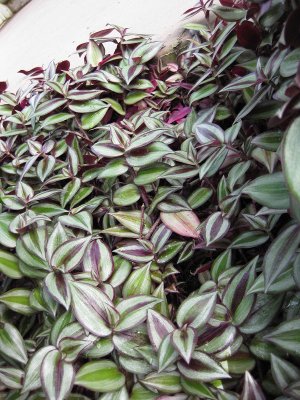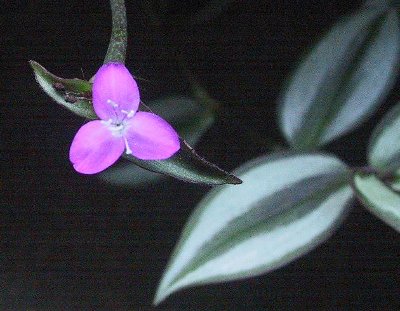Zebrina
 Common names: Wandering Jew, Inch Plant
Common names: Wandering Jew, Inch Plant
Scientific name: Tradescantia zebrina
Climate: Tempered
Plant description: Creeping or hanging plants with attractive oval-shaped leaves with a tip and green and silver color on the upper side and a beautiful purple color on the underside.
The tricolor leaves are lanceolate and sit at the base surrounding the neck of the stem. About 3-5 cm in length and about 2 to 3 cm wide.
On the upper side it has two white bands on both sides of the blade, the central area and the edges of the leaves being dark green, while on the underside they are purple.
It does not exceed 30 cm in height due to its weak stems unless they are supported directly on a wall or some structure.
It has attractive greenish purplish leaves, the newer and uppermost purple, and the older and lower green with two silver stripes, the older leaves showing a uniform deep magenta.
In spring - summer it presents small reddish-pink flowers with three petals grouped in a terminal structure of the stems blooming one by one.
Cultivation: It can be sown directly into the substrate. It is very easy to multiply it with cuttings, which are rooted in water.
It requires a lot of light, since otherwise, all the tones of its beautiful coloring will be more muted. It does not support dark places; it becomes elongated and the leaves tend to lose their variegation and turn completely green. Nor does the direct sun go to it because it discolors it.
The nuanced or variegated variety needs more light than the common varieties.
It is a plant that supports some cold 5ºC although it does not die until -3ºC. It is advisable after a hard winter to prune it so that it regrows strongly in spring. It is a plant adapted to dry climates, with which it supports drought, although it needs some irrigation.
It easily reproduces by cuttings throughout the year. The lower blades should be removed to make it easier to grip.
Uses: Commonly sold as a houseplant.
Also used as a ground cover, it aggressively colonizes new areas. It is easily manipulated.
Plant widely used in patios in pots, as an indoor plant and as a floor covering plant in shady areas.
In the southeast of Mexico, a refreshing drink is prepared by cooking the leaves of this plant, the resulting cooking is strained to remove the leaves and lemon juice and sugar are added to the water, it is drunk cold and it is attributed anti-inflammatory, diuretic and Kidney detoxifiers as well as a cure for dysentery.
The plant contains different secondary metabolites, which are responsible for its healing properties, among which are tannins, saponides, flavonoids and steroids.
Plagues and diseases: They are very resistant to diseases, but when the heat is very intense they can suffer attacks from aphids, spider mites and mealybugs.
It suffers from a disease that are fungal leaf spots, Rust (bumps) and Botrytis in high humidity conditions rot stems and leaves that are covered with a gray mold.
References:
colaboradores de Wikipedia. (2019, November 27). Tradescantia zebrina. Wikipedia, La Enciclopedia Libre. https://es.wikipedia.org/wiki/Tradescantia_zebrina
Huesca, M. (2019, September 19). Tradescantia Zebrina – Para Mi Jardín. Para Mi Jardin. https://paramijardin.com/plantas/interior/tradescantia-zebrina/
Plantas, C. (n.d.). Tradescantia zebrina, Zebrina o Panameña | Cuidados. Consulta Plantas. Retrieved November 7, 2020, from http://www.consultaplantas.com/index.php/plantas-por-nombre/plantas-de-la-s-a-la-z/787-cuidados-de-la-planta-tradescantia-zebrina-zebrina-o-panamena
En español: Matali
